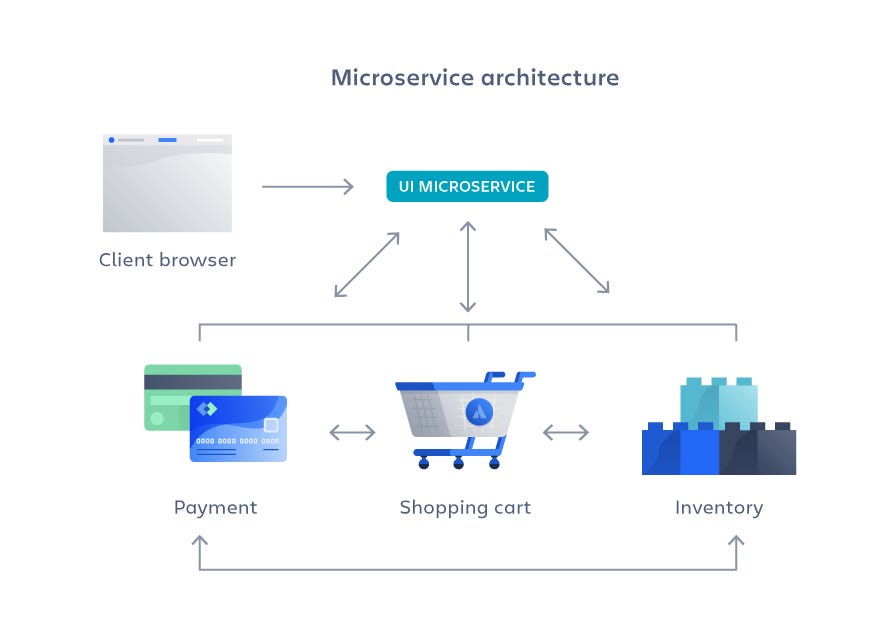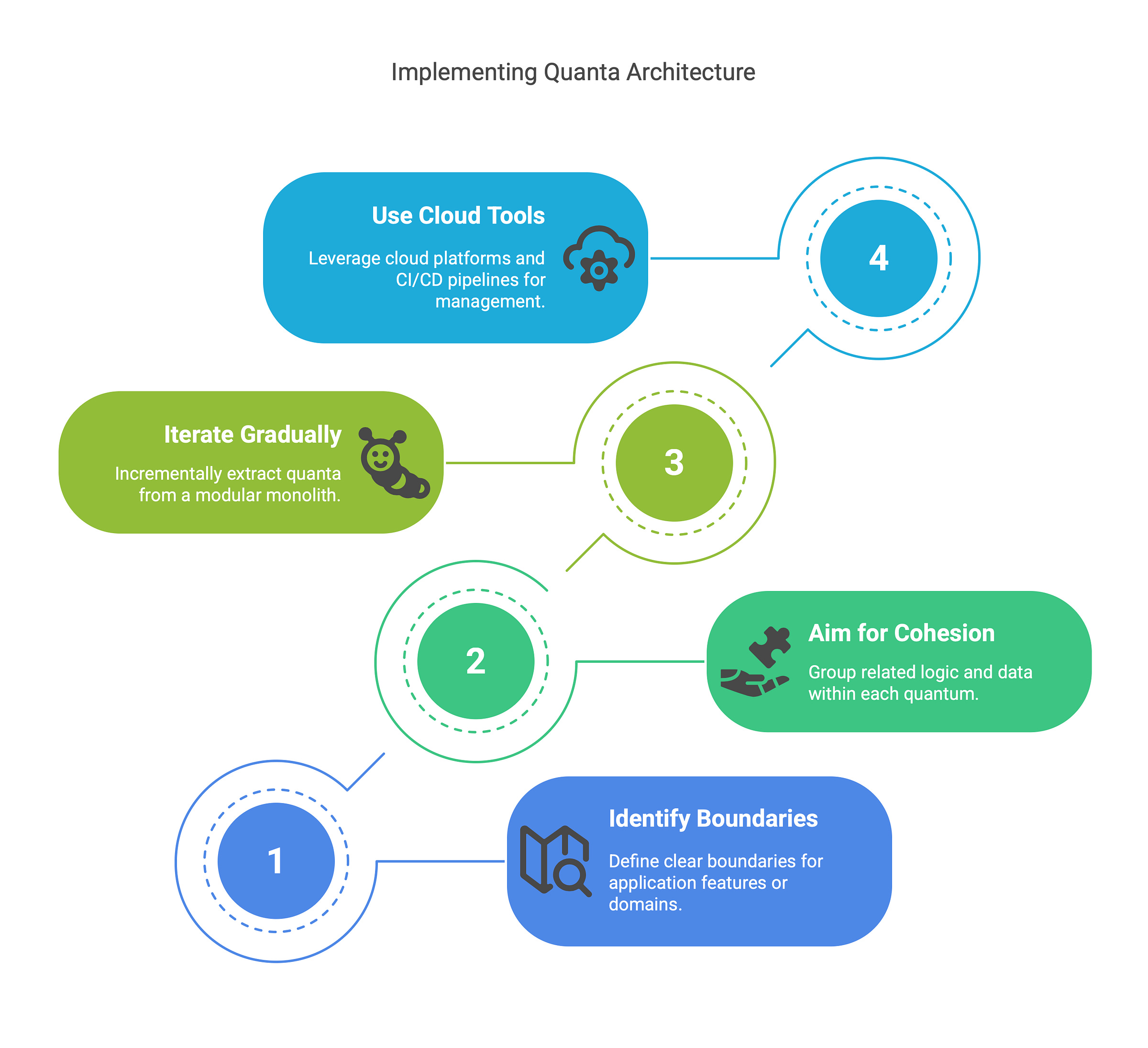Architecture Quantum
Software architecture
Modern web and cloud-native systems thrive on breaking big applications into smaller, well-defined pieces. Architectural quanta are the self-contained “blocks” of your software – think of them like Lego bricks or building blocks of a codebase. Each quantum is a highly cohesive component that can stand on its own and be deployed independently. In simple terms, an architectural quantum is “an independently deployable component with high functional cohesion”1. The idea (coined by Neal Ford and colleagues) is to keep these blocks as small and focused as possible, which makes the overall system more scalable, maintainable, and evolvable.
Architectural quanta are like Lego bricks: self-contained pieces you can snap together or swap out. Just as a Lego brick includes all the studs it needs to connect, an architectural quantum bundles together code, data, and infrastructure so it can run on its own.
Architecture Characteristics Worksheet: Are You Defining Your Architecture or Letting It Define You?🤔
Most engineering teams focus heavily on functional requirements - what the system should do. But what about how it should perform, scale, or adapt to change?
Monoliths, microservices, and quanta
To see architectural quanta in action, let’s compare different styles. In a monolithic architecture, the entire application is one big quantum – a single deployable unit that contains all features. All the code (for payments, shopping cart, inventory, etc.) lives together, and when you deploy or scale the app, you do it all at once. For example, imagine an online store where one giant server runs everything. In this setup, you cannot deploy or scale parts separately: you have to update the whole app even for a small change2.

In contrast, a microservices architecture breaks the system into many small quanta3. Each service (e.g. Payment Service, Cart Service, Inventory Service) is its own tiny application with its own code and data. The client browser can send requests to any of these services. Because each service is independent, you can deploy, update, and scale them separately. For instance, if the Shopping Cart service is overloaded, you can spin up more instances of that service alone, without touching the Payment or Inventory services. This makes the system highly flexible and scalable, since only the busy parts need more resources.

A modular monolith sits in between: it’s still one deployable app, but its code is organized into clear modules (e.g. a User module, a Billing module). Modules help developers work more cleanly, but unlike true quanta, the app still deploys as a whole. Architectural quanta take this further: each module or domain might become its own service (its own quantum) if it’s cohesive enough. As one practitioner notes, “aiming to scope modules as architectural quantum, [i.e.] an independently deployable component with high functional cohesion”4. In practice, teams often start with a modular monolith and then extract modules into separate quanta over time.
Why quanta matter: scale, maintainability, and evolution
Using architectural quanta has big benefits for web and cloud applications.
Scalability. Small quanta allow fine-grained scaling. In a monolith, “you can’t scale individual components” – you must replicate the whole app. With quanta (like microservices or cloud functions), if one part gets busy you only scale that service. For example, if many users add items to cart, you just run more copies of the Cart quantum. This is especially powerful in the cloud, where you can autoscale each quantum separately on demand.
Maintainability and Agility. Teams can update one quantum without redeploying everything. As Atlassian observed, in a microservices setup “each service can be developed, updated, deployed, and scaled without affecting the other services”. This means faster updates: bugs or new features touch only a small codebase. Indeed, companies often go from weekly releases to multiple deployments a day when moving to quanta. Faults are also isolated: a crash in the Payment quantum won’t take down the Inventoryquantum, so the rest of the app stays alive.
Smaller Teams and Ownership. Quanta let teams “own” a piece end-to-end. In the cloud era, it’s common to give a small “two-pizza” team one quantum (one service or module) to manage. This boosts productivity and morale – Atlassian notes that teams working on microservices are “a lot happier, since they are more autonomous and can build and deploy themselves”. Similarly, Netflix famously split its monolith into over a thousand quanta (microservices), with each team deploying code many times a day. This extreme break-down let Netflix scale massively in the cloud and evolve features quickly.
System Evolution. Over time requirements change. With quanta, you can evolve one part without breaking others. If you need a new checkout feature, you can rewrite just the Checkout quantum. If a database schema changes, you handle it inside that quantum or between two quanta, rather than refactoring a huge monolith. The idea is summed up neatly: “small architectural quanta… [help] make an evolvable architecture”. This “evolutionary” approach to architecture (championed in recent practice) relies on these small deployable units to adapt to new demands with minimal disruption.
Quanta vs. other concepts
It helps to contrast architectural quanta with related ideas:
Module or Component vs Quantum: A module (in code) is just a way to organize related functions. In a monolith you might have a User module or Payment module, but it’s not independently deployable. An architectural quantum does include everything it needs (code, database, etc.) to run alone. In other words, a module becomes a quantum only when it can stand on its own deployment pipeline.
Microservice vs Quantum: Microservices are small quanta, but not all quanta have to be microservices. Quanta is a broader term: you can have a very small quantum (like a single cloud function or container) or a moderate one (like a service handling several related features). The guiding principle is cohesion and independence. As one review puts it, “microservices have small quanta compared to monoliths”. In practice, think of a quantum as any piece you treat like its own mini-application.
Bounded Context vs Quantum: In domain-driven design, a bounded context is a boundary around a business domain (like “Orders” or “Inventory”). A bounded context often naturally maps to an architectural quantum. Turning each bounded context into a deployable quantum is even said to give “the best return of investment”, because it aligns technical boundaries with business domains.
Service-Oriented / Microkernel vs Quantum: Older service-oriented architectures (SOA) or plugin architectures share similar goals of modularity, but quanta emphasize deployability and dev velocity. For example, SOA used heavyweight middleware, whereas today a quantum might just be a lightweight REST service or serverless function. Similarly, a microkernel design (core app with plugins) is about extensibility; quanta are about independent evolution of each piece.
In summary, architectural quanta is a way to think about how big each piece of your system should be. It complements familiar ideas: break code into cohesive modules or services, but go further by giving each piece its own deploy pipeline and autonomy.
Getting started with quanta
For web and cloud-native teams, embracing quanta often means:
Identify boundaries: Look at your application’s features or domains (e.g. user accounts, catalog, checkout). These often suggest natural quanta. Use domain-driven design or simple business functions to guide your splits.
Aim for cohesion: Group together only things that really belong. A payment quantum should contain all payment logic (and maybe its own database) and no unrelated code. High cohesion and loose coupling are key.
Iterate gradually: You don’t have to start with thousands of services. Many teams begin with a modular monolith (well-structured codebase) and then incrementally extract quanta. Each time you split off a piece as its own service or container, you’re reducing your “quantum size”.
Use cloud tools: Cloud platforms, containers (Docker/Kubernetes), and CI/CD pipelines make quanta manageable. Each quantum can be a container, function, or cloud service with its own deployment. Automated testing and deployment pipelines (continuous integration) help verify each quantum independently, ensuring the whole system stays healthy.
Architectural quanta aren’t a silver bullet, but they simplify complex systems in today’s cloud world. By treating each logical piece as its own deployable unit, teams gain flexibility. Monoliths give way to Lego-like landscapes of services and modules – easier to scale, evolve, and maintain. Whether you’re running a startup’s web app or a global cloud service, thinking in terms of quanta can help your architecture grow smarter and faster.
The concept of architectural quanta comes from Building Evolutionary Architectures by Neal Ford et al. Practical experiences from companies like Netflix and Atlassian show how breaking systems into independently deployable pieces enables scalability and agility. Technical blogs and architecture guides reinforce that small, cohesive components (high cohesion and independent deployment) lead to more evolvable software. These ideas are widely discussed in modern software architecture literature and industry case studies.
Summary
The term "architecture quantum" refers to a modular unit within software architecture that can operate and be deployed independently within a system. Key characteristics of an architecture quantum include its independence in deployment, high functional cohesion (where components work together to perform specific tasks), and varying degrees of static and dynamic coupling. Understanding and applying the concept of architecture quanta helps engineers by enabling them to break down complex systems into manageable units, facilitating easier deployment, testing, and scaling, and allowing for a more precise analysis of system characteristics such as flexibility and fault tolerance.











Love the Lego brick framing. In investing, portfolios work the same way — cohesive building blocks that stand alone, but snap together into something scalable. The danger comes when your ‘quanta’ are too tangled to evolve.